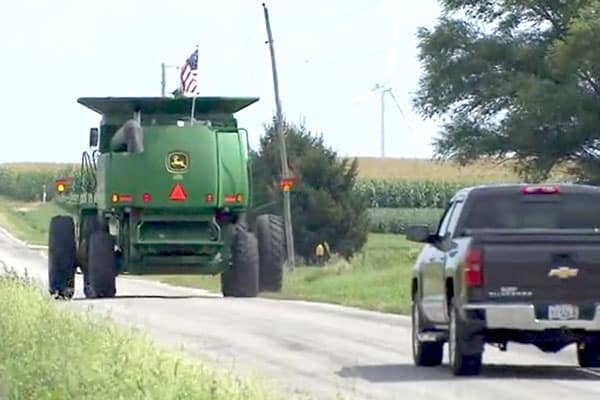Farm Vehicles and Rural Road Safety During Harvest Season

The work of our farmers to earn a living and feed a nation calls us to do our part to make rural roads safer during harvest.
Farm vehicle activity during harvest season increases.
Amidst the picturesque scenes of the fall harvest, a pressing concern emerges—the safety of farm vehicles on rural roads.
Harvest season is the culmination of months of hard work, representing the peak of farming activity. It is when farmers earn their income and contribute significantly to our nation's food supply.
Farmers work long days to bring in their crops before adverse weather arrives. As a result, the number and frequency of tractors and other farm equipment on rural roadways dramatically increases.
This often creates unexpected delays and challenges for other drivers.
Rural road hazards.
Rural roads often lack the standard infrastructure of rural communities and business districts. Many townships keep their rural roads in good condition. However, rural roads often remain narrow, winding, and visually obstructed due to the growing crops. They may also lack proper traffic signage and markings.
Moreover, in addition to local farm traffic, these roads are frequently shared by cars, trucks, buggies, and bicycles. This mix of vehicles and increased farm traffic during harvest increases the risk of unexpected events and accidents.
The challenges of farm and non-farm vehicles on rural roads.
Farm vehicles are essential during harvest season, but they present challenges when sharing rural roadways.
For example, tractors typically move slower than other vehicles, and their larger size can obstruct the view of other drivers, especially on winding roads. Farm vehicles may also require a longer stopping distance, which can be particularly dangerous when necessary to avoid an accident.
Older tractors may lack the same safety features as newer equipment, making their occupants more vulnerable in case of an accident. Regardless, the most significant challenge for farm vehicles and the traffic that must accommodate them is the immense size and weight of farm machinery.
Human factors contribute to the hazardous conditions.
Farm vehicle safety isn't just about machinery and road conditions; it also involves human behavior.
Fatigue, distractions, and experience can all contribute to accidents involving farm equipment on rural roads.
Like other drivers, farmers are also susceptible to distractions like smartphones or radios that can divert their attention from the road. Proper training, public awareness, and personal safety decisions every time you drive are essential to reducing behaviors that contribute to accidents.
Promoting public awareness.
The Illinois Farm Bureau provides the following safety tips for rural areas during harvest:
Tips for Farmers
- Do everything possible to alert motorists to the presence of your farm equipment and slow travel speed.
- Plan travel to avoid rush hours, bad weather, the busiest roads, and the time before daylight and after dark.
- Be obvious to motorists by proper use of reflective “Slow-Moving Vehicle” emblems on any implement operated on public roadways. It’s the law!
- Use reflective marking tape and reflectors at the extremities of equipment.
- Turn on hazard lights mounted on farm equipment and turn off field work lights for all roadway travel.
- Install mirrors that are wide enough for you to see what is following you.
- Always use turn signals to indicate plans to turn into fields or driveways.
- Be aware of traffic—oncoming, in front of you, and behind you.
- If road and shoulder conditions are safe, pull over temporarily to allow traffic to pass.
- Slow down on turns and curves. Check the traffic behind you.
- Minimize the width of equipment as much as possible. You may not interfere with traffic in an adjoining lane.
- When practical, truck larger equipment to the next location.
Tips for non-farm motorists (cars, bicycles, buggies, and other roadway vehicles)
- Above all, slow down and be patient.
- Reduce speed when encountering farm equipment on public roads. Flashing amber lights mean “caution.” The orange and red reflective triangle also warns you that the tractor or combine travels at a slow rate of speed.
- Keep a safe distance from the farm equipment so farmers can see you. If you can’t see their mirrors, they can’t see you.
- Pass wide, large farm equipment only if you know conditions are safe, and you are sure the farmer will not be making a left or right-hand turn. Be cautious when pulling back in.
- Passing in a no-passing lane or within 100 feet of an intersection, railroad crossing, or bridge is illegal.
- Be prepared to yield to wide equipment. Large farm vehicles often need to slow down and move to the left or right of the road to make wide turns.
- Always wear a safety belt and heed the road’s speed limit and conditions.
- Watch for the farmer’s indication of a turn. Newer equipment has one or more amber lights flashing rapidly to indicate a turn. Older equipment is typically not equipped with turn signals, so watch for the farmer’s hand signals.
Safer rural roads: It’s up to us!
Ensuring farm vehicle and rural road safety for everyone during harvest season requires a collective effort.
Safe and alert driving, as well as respectful and patient behavior among all road users, are vital to reduce the risk of accidents.
The Moultrie County Health Department wishes a safe and bountiful harvest season to all our local farmers, agricultural workers, and surrounding communities.

